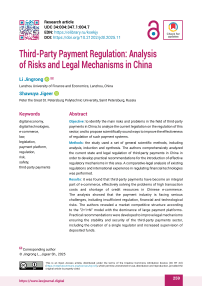Third-Party Payment Regulation: Analysis of Risks and Legal Mechanisms in China
Автор: Jingrong L., Jigeer Sh.
Журнал: Journal of Digital Technologies and Law @lawjournal-digital
Статья в выпуске: 3 (2), 2025 года.
Бесплатный доступ
Objective: to identify the main risks and problems in the field of third-party payments in China; to analyze the current legislation on the regulation of this sector; and to propose scientifically sound ways to improve the effectiveness of regulation of such payment systems. Methods: the study used a set of general scientific methods, including analysis, induction and synthesis. The authors comprehensively analyzed the current state and legal regulation of third-party payments in China in order to develop practical recommendations for the introduction of effective regulatory mechanisms in this area. A comparative-legal analysis of existing regulations and international experience in regulating financial technologies was performed. Results: it was found that third-party payments have become an integral part of e-commerce, effectively solving the problems of high transaction costs and shortage of credit resources in Chinese e-commerce. The analysis showed that the payment industry is facing serious challenges, including insufficient regulation, financial and technological risks. The authors revealed a market competitive structure according to the “2+1+N” model with the dominance of large payment platforms. Practical recommendations were developed to improve legal mechanisms ensuring the stability and security of the third-party payments sector, including the creation of a single regulator and increased supervision of deposited funds. Scientific novelty: the study complements the scientific base in the field of financial technology regulation, systematizing the main risks of the third-party payments sector and analyzing the modern regulatory framework. It takes into account the latest changes in the industry, which allows the authors to form a comprehensive understanding of the legal challenges in this area. For the first time, an integrated risk assessment model for third-party payment systems was proposed. Practical significance: the findings have practical implications for improving regulatory efficiency, which is relevant both for third-party payment service providers and for financial regulators when developing policies in the field of financial technology and digital payments. The results can be used to improve the legislative framework and create specialized financial supervisory authorities.
Digital economy, digital technologies, e-commerce, law, legislation, payment platform, regulation, risk, safety, third-party payments
Короткий адрес: https://sciup.org/14132939
IDR: 14132939 | УДК: 34:004:347.1:004.7 | DOI: 10.21202/jdtl.2025.11


